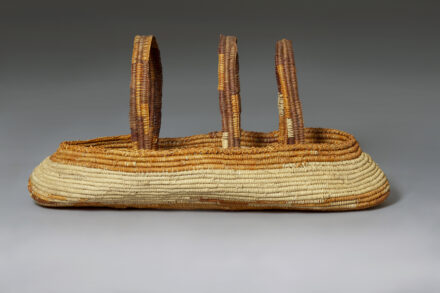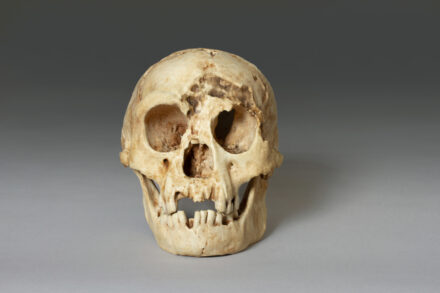
Article by Dr Robin Hide
Honorary Senior Lecturer,
School of Culture, History and Language, ANU

The SoAA collection holds 15 gourd artefacts. Though small, this interesting collection represents some of the wide range of uses to which gourds have been put by the people of New Guinea. The great majority of gourd artefacts surviving in museum collections around the world, including the SoAA one, are made from the dried, hard, fruit shell of the cultivated bottle gourd (Lagenaria siceraria).
Before the mid to late nineteenth century, such gourds, along with another ubiquitous natural product, bamboo, were used as containers for many purposes in New Guinea. These included containers for water, for cosmetic oils and fats, for lime (used with betel nut chewing), and for storing the seeds of some crops. More dramatically, gourds were also used in some parts of the country as penis sheaths (phallocrypts), and elsewhere for crafting masks for ceremonial and other purposes. With the advance of the colonial frontier, however, gourds were rapidly, and almost universally, displaced by industrial products of tin, glass and plastic. By the early twenty-first century it was rare to find gourd plants still being cultivated anywhere in the country.
The SoAA collection of gourds includes a range of artefacts illustrating some of these uses: containers for water (c. six items), for fat or oil (possibly one item), and for lime (three items); one phallocrypt; and, less usual, two neck ornaments displaying very small (less than 5 cm diameter) gourds. The everyday use of many of the containers is reflected in their simple, undecorated appearance (Fig. 1). The only items displaying designs incised or burned on the gourds are two of the lime containers (Fig.2), and one of the small neck ornament gourds (Fig.3).

While acquisition dates are unavailable for some of these artefacts, it appears that most were acquired between the mid ’50s and mid ’60s. The majority (ten items) were collected by two of the early ANU graduate student anthropologists in their field locations in the New Guinea Highlands in the mid ’50s: the late Ralph Bulmer with Enga speakers in the Baiyer Valley (three large containers, and the two neck ornaments), and the late Bob Glasse with Huli speakers at Tari (five large water containers). The phallocrypt (from the Baliem Valley in what is now Indonesian Papua) was acquired from a missionary in 1959 by the late John Barnes, then the Professor of Anthropology in RSPAS. While acquisition documentation is lacking for the three lime containers, the distinctive forms and ornamentation of two point to possible origins in Manus and the Sepik. The shapes and large sizes of thirteen of the fifteen gourds mean that they were the products of Lagenaria, the bottle gourd. More problematic are the two, very small, neck ornament gourds (3-4 cm in diameter) from the Baiyer Valley. While small fruits are possible from Lagenaria, they could be from another, wild, plant of the same cucurbit family (Benincasa hispida) which research in progress shows is fairly widespread in New Guinea and may be the currently unrecognised source of a variety of artefacts from New Guinea in museum collections.




